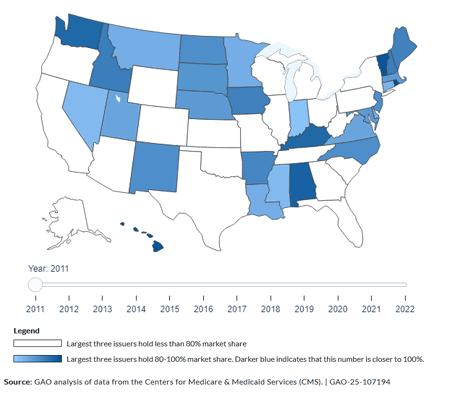GAO Highlights Increasing Health Insurance Costs
Per the notice below, the United States Government Accountability Office (GAO) is highlighting the increasing cost of health insurance.
Health Insurance Costs Are Increasing As Markets Become More Concentrated with Fewer Insurance Companies (interactive map)
One trend that may be contributing to higher insurance costs is the growing market concentration among fewer insurance companies. We recently looked at changes in private health insurance market concentration. We also compared costs under two types of private health plans—employer-sponsored plans and individual plans offered on the Healthcare.gov Marketplace. Today’s WatchBlog post looks at what we found and reported in two new reports about these trends.

Private insurance is getting more concentrated, which could raise prices of health coverage
Over the last decade or so, the number of private health insurance companies in each state has decreased. And in many states, just a few companies may insure most private policy holders. Concentrated markets are concerning. As markets become more concentrated, they may also become less competitive. This may result in higher premiums, decreased access to affordable health insurance, and fewer options for consumers. We consider a state’s market to be concentrated when three or fewer insurance companies hold at least 80% of the market share of enrollment. This concentration has been seen in many states for years. In our November report, we looked to see if concentration trends were true across different private insurance markets—the individual market, and markets for small and large employers. We found that all three markets have become more concentrated.
States and D.C. Where the 3 Largest Insurance Companies Had At Least 80% of Enrollment, 2011-2022

Individual market. People without employer-sponsored health coverage may get coverage through the individual market, including through the individual exchanges using Healthcare.gov. In 2022 most people—about 13.5 million—who got their health coverage in the individual market did so through individual exchanges. When we looked across states, we found that the individual market became more concentrated from 2011 through 2022. At its peak in 2019, 47 states were concentrated. However, since then, enrollment has become less concentrated with the number decreasing to 35 states in 2022.
Small-employer group market. Over 11 million people enrolled in insurance plans in 2022 through small-employer group health insurance. This market also became more concentrated from 2011 through 2022—with 47 states having concentrated markets in 2022. The rate of concentration has slowed more recently.
Large-employer group market. The large-employer group market is also the largest of three market types with more than 40 million people enrolled in insurance plans in 2022. Over the years, this market has remained concentrated with only slight increases from 40 states in 2011 to 43 states in 2022.
Why are markets so concentrated? Increased market concentration has often been the result of consolidation—mergers and acquisitions—among existing insurance companies. However, concentration can also increase if existing health insurance companies leave the market, reducing the number of issuers from which consumers can purchase coverage. And high concentration can make it difficult for new issuers to enter a market. Perpetuating the issue.
Our interactive map allows a look into how states’ market concentration compare. Click on the graphic below (and linked here) to check it out.

How do costs under employer-sponsored plans compare to those on Healthcare.gov?
Private health coverage is the most common source of health coverage in the United States. And according to national estimates, spending on private health coverage may exceed $1.5 trillion this year. These costs are growing and can have a significant impact on Americans. About 165 million Americans get their health coverage through employer-sponsored plans. Under these plans, an employer and employees typically share the cost to purchase coverage—referred to as the premium. Those who don’t have employer-sponsored plans can get coverage through the individual market, such as Healthcare.gov Marketplaces plans. As previously stated, in 2022, 13.5 million people signed up for Marketplace plans—under which the federal government and the policy holder typically share the cost of the premium. In a new report, we compared premiums under employer-sponsored plans with gold, silver, and bronze tier individual plans purchased on the Marketplace. We found that employer-sponsored plans had, on average, lower estimated premiums per person covered than Marketplace plans. But employer-sponsored plans also required higher estimated contributions from those covered. Specifically, when we looked across 33 states that were included in our review, we found:
- Monthly per person premiums were on average $54 lower under employer-sponsored plans
- Monthly per person contributions were on average $41 higher for employer-sponsored plans.
Comparison of Per Person Premiums and Enrollee Contributions across 33 states, 2022

This comparison is complicated by differences between employer-sponsored and Marketplace plans—including in covered populations, plan designs, and tax treatment. We outline more of the differences between these two types of private health plans in our full report from November. You can also learn more about our work on health care costs by checking out our special issues page about federal health care spending.

